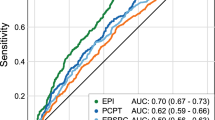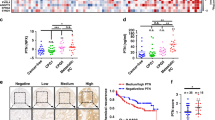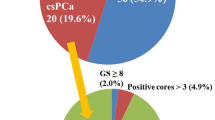Abstract
As high grade PIN is commonly associated with concomitant cancer, current literature recommends re-biopsy of patients with high grade PIN. This paper describes the prevalence of high grade prostatic intra-epithelial neoplasia (PIN) from three independent clinical settings, reported by a single pathologist (MCP). High grade PIN was diagnosed in biopsies from 131 of the 1205 (11%) of patients in whom cancer was suspected in hospital practice, 42 of the 202 (20%) asymptomatic men screened for prostate cancer and 29 of the 118 (25%) patients presenting with prostatism in a case finding study.
Re-biopsy on this scale has major clinical and cost implications. However, from a literature review, there is evidence to suggest that the risk of concomitant cancer with high grade PIN may be stratified according to serum PSA. This opinion should be tested prospectively.
This is a preview of subscription content, access via your institution
Access options
Subscribe to this journal
Receive 4 print issues and online access
$259.00 per year
only $64.75 per issue
Buy this article
- Purchase on SpringerLink
- Instant access to full article PDF
Prices may be subject to local taxes which are calculated during checkout
Similar content being viewed by others
Author information
Authors and Affiliations
Rights and permissions
About this article
Cite this article
Feneley, M., Green, J., Young, M. et al. Prevalence of prostatic intra-epithelial neoplasia (PIN) in biopsies from hospital practice and pilot screening: clinical implications. Prostate Cancer Prostatic Dis 1, 79–83 (1997). https://doi.org/10.1038/sj.pcan.4500210
Received:
Revised:
Accepted:
Issue date:
DOI: https://doi.org/10.1038/sj.pcan.4500210
Keywords
This article is cited by
-
Contemporary clinical management of isolated high-grade prostatic intraepithelial neoplasia
Prostate Cancer and Prostatic Diseases (2008)



